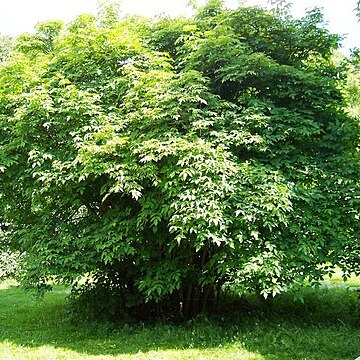Shrubs, rarely trees. Stems branched [single]. Leaves deciduous [persistent], cauline, opposite, usually ternate [odd-pinnate, 1-foliolate]; stipules caducous, extrapetiolar [intrapetiolar], distinct [connate]; petiole present; blade herbaceous, margins serrulate to serrate or crenulate-serrulate; ?leaflets: articulations or petiolule bases with 2 glands or stipels?. Inflorescences terminal [axillary], thyrses, drooping. Flowers bisexual [unisexual, plants dioecious], perianth and androecium hypogynous; epicalyx bractlet absent; hypanthium short-campanulate; sepals 5, distinct or basally connate; petals 5, distinct; nectar disc lobed, ?surrounding bases of ovaries?; stamens 5 in 1 series (alternating with nectary lobes), distinct, ?anthers X-shaped or sagittate, alternipetalous?; pistils 1[–2], ?[2–]3(–4)-locular, carpels connate [distinct], ovary: placentation axile or axile-basal?, styles ?(2–)3(–4)?, basally connate, distally postgenitally connate, stigmas expanded, flattened; ovules [1–]3–12 per locule. Fruits capsules [berries], ?inflated, usually 3-lobed, carpels becoming distinct distally, tardily so adaxially, and apically dehiscent; styles persistent, splitting?. Seeds 1 or 2 per locule, not arillate [arillate].
More
Trees or shrubs, deciduous or evergreen. Leaves opposite, odd-pinnately compound, or trifoliolate, rarely simple, stipulate or exstipulate; leaflets with petiolules, less commonly subsessile, pinnately veined. Flowers bisexual to rarely unisexual, pinkish to white, pendent or erect, actinomorphic and hypogynous, arranged in panicles or racemes. Sepals 5, often petaloid, caducous or persistent, imbricate. Petals 5, free or connate at base, imbricate, rarely valvate, as equal as sepals. Stamens 5; filaments free or inserted on corolla tube, alternating with corolla lobes; anthers dehiscing by longitudinal slits. Disk annular to barely discernible. Gynoecium superior; carpels 2 or 3(or 4), free or weakly united, lobed ovary with as many locules as carpels; style free or slightly united; ovules 1 to several and arranged in 2 rows. Fruits inflated capsules or follicles or berrylike drupes. Seeds globose to ovoid; arillode present or absent.

